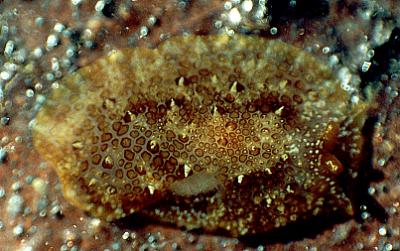
Pleurobranchus atlanticus
Abbott, 1949
Order: NOTASPIDEA
Superfamily: PLEUROBRANCHOIDEA
Family: Pleurobranchidae
DISTRIBUTION
Caribbean, tropical west Atlantic.
PHOTO
Santa Marta, Caribbean coast of Colombia. 3-5 cm long. Photos: Phanor Montoya.
This appears very similar in colour to the Indo-West Pacific species Pleurobranchus albiguttatus and I previously labelled it as Pleurobranchus cf. albiguttatus on the Forum. I have now identified it as Pleurobranchus atlanticus, a species previously considered a synonym of Pleurobranchus areolatus. See Anne Dupont's message below where I discuss its identity in more detail.
Pleurobranchus evelinae Thompson, 1977 is also a synonym [see message.]
References:
• Abbott, R.T. (1949): A new Florida species of the Tectibranch genus Pleurobranchus. The Nautilus, 62(3): 73-78.
• Mörch, O.A.L. (1863) Contributions à la Faune malacologique des Antilles danoises. Journal de Conchyliologie, 11: 21-43.
• Thompson, T.E. (1977) Jamaican opisthobranch molluscs I. Journal of Molluscan Studies, 43(2): 93-139, pls.1-3.
• White, K.M. (1952) On a collection of molluscs from Dry Tortugas, Florida. Proceedings of the Malacological Society of London, 29: 106-120, Pl.6.
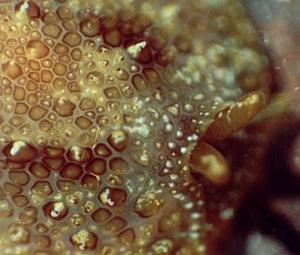
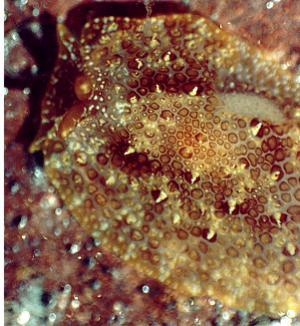
Rudman, W.B., 2000 (October 21) Pleurobranchus atlanticus Abbott, 1949. [In] Sea Slug Forum. Australian Museum, Sydney. Available from http://www.seaslugforum.net/find/pleuatla
Related messages
Pleurobranchus atlanticus from Bonaire
November 16, 2009
From: Marianne Ligthart
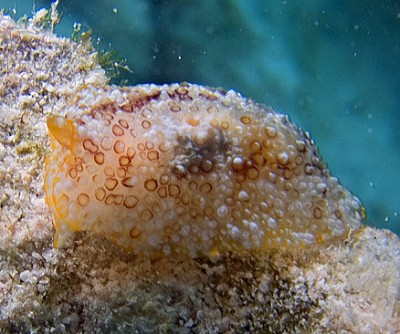
Dear Bill,
Though we know it does not concern a real seaslug we ask your help for identification!
Diving at Bonaire, at Petries Pillar, we found this little animal creeping on dead coral rubble at a depht of 4 - 5 meters.
At first we were, not succesfully, searching in the direction of Velutinidae and Lamellaridae because we expect a little shell inside. One siphon was clearly visible. Size: 15 - 20 mm.
Behavior: fast and active.
Shape: a bit flat, almost like a flatworm.
We saw one specimen.
There is some resemblance with Pleurobranchus areolatus. But finally we think that is not possible.
We hope you can give us more information!
Locality: Divesite: Petries Pillar. South-westcoast of Bonaire, near Kralendijk., 4 -5 m, Bonaire, Caribbean Sea, 01 March 2009, On dead coral rubble.. Length: 15 - 20 mm. Photographer: Marco Faasse.
With greetings,
Marianne Ligthart
ahmligthart@hetnet.nl
Ligthart, M., 2009 (Nov 16) Pleurobranchus atlanticus from Bonaire. [Message in] Sea Slug Forum. Australian Museum, Sydney. Available from http://www.seaslugforum.net/find/22784Dear Marianne,
This is definitely a pleurobranch sea slug. It is the species I am calling Pleurobranchus atlanticus. Although not clear in your photo, some of the tubercles have triangular white patches on them creating the impression that there are pointed white tubercules scattered over the back.
In Caribbean Sea Slugs this species is identified as Pleurobranchus crossei Vayssiere but as I discussed earlier [message #18917], I don't think the authors got their pleurobranchs quite right.
Best wishes,
Bill Rudman
Pleurobranchus atlanticus from Florida
September 20, 2007
From: Jay Wilmar
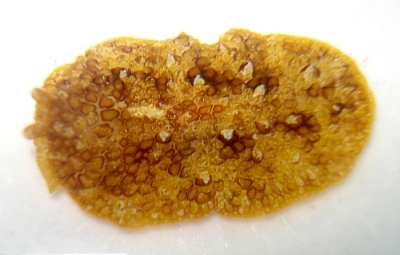
Hello,
I came across this animal in shallow intertidal waters on South Florida's Atlantic coast. Not sure what it is an I was hoping someone can assist in identifying these?
Locality: channel, 3 feet, Florida, USA, Atlantic Ocean, 8 september 2007, intertidal. Length: 1 inch. Photo: Jay Wilmar
Jay Wilmar
Naturalmc1@hotmail.com
Wilmar, J., 2007 (Sep 20) Pleurobranchus atlanticus from Florida. [Message in] Sea Slug Forum. Australian Museum, Sydney. Available from http://www.seaslugforum.net/find/20751Dear Jay,
This is Pleurobranchus atlanticus. For those of you with the new Caribbean book, Caribbean Sea Slugs, this species is identified there as P. crossei. As I have discussed in an earlier message [#18917], I don't agree with that decision.
Best wishes,
Bill Rudman
Pleurobranchus atlanticus and P. crossei
December 13, 2006
From: Bill Rudman
While answering Hugues Flodrops' message [#18785] on whether Pleurobranchus albiguttatus and P. atlanticus were synonyms, I had a look at my earlier comments on Anne Dupont's message [#5301] where I discuss the identity of P. atlanticus in some detail, including commenting on earlier names for Caribbean pleurobranchs. I also looked at how Valdes et al. (2006) had treated the topic in their new Caribbean book, Caribbean Sea Slugs, and was somewhat surprised at what they have done. They accept two species, P. evelinae and P. crossei. In earlier messages I considered P. crossei [#5301] to be a synonym of P. areolatus, and P. evelinae [#10936] to be a synonym of P. atlanticus. It seems pointless to repeat the arguments here
Unfortunately they have apparently missed my comments, as they do not refer to them and don't mention the most distinctive external feature which is the series of slightly larger tubercles down each side of the dorsal midline which each have a white triangular mark on them. This is the most distinctive feature on the Indo-West Pacific species P. albiguttatus and also in P. atlanticus. This is the reason I considered P. evelinae as a synonym of P. atlanticus.
In their book they consider P. evelinae as a distinct species, and yet you can clearly see the white triangles in their photo of it, although they don't mention them in the text. They also consider there is a second Caribbean species with the same colour pattern which they give the name P. crossei Vayssiere, 1897, and consider P. atlanticus to be a junior synonym. As I mention above, I suggested P. crossei was a synonym of another Caribbean species, P. areolatus, but any discussion is pointless because the species was based on a 22 mm long preserved specimen, for which the author had no colour information. As Vayssiere (1898) comments, "after a long sojourn in alcohol (from 1826 to 1896) the specimen has lost all traces of colour" - my translation. It is a colourless, unidentifiable juvenile specimen. I can't see any value in trying to identify it, and for the sake of nomenclatural stability should be treated as a nomen oblitum. Otherwise there is nothing to stop another group of authors re-identifying it as something else. They next list Pleurobranchopsis aurantiaca Verrill, 1900 as a synonym. This name has a complicated nomenclatural history. Thiele (1931) considered Pleurobranchopsis to be a subgenus of Pleurobranchus which meant that Pleurobranchus aurantiacus Verrill became a homonym of the Mediterranean Pleurobranchus aurantiacus Risso, 1818. To solve this homonymy Thiele introduced a new name Pleurobranchopsis verrilli Thiele, 1931, which Valdes et al also include in the synonymy of P. crossei.
Apart from this nomenclatural confusion there remains the question of just what Pleurobranchopsis aurantiaca Verrill is. Unfortunately the holotype is missing from the Yale Peabody Museum. Clark (1984) suggests the most likely identity is Berthella agassizii (Macfarland, 1909) which was also described from Bermuda. He notes:
"This species closely matches the description of Pleurobranchopsis aurantiaca Verrill, 1900, except that Verrill's description explicitly noted the absence of a shell. As noted here, the shell is highly transparent and easily overlooked in live animals, and this might explain Verrill's establishment of the shell-less genus Pleurobranchopsis. Willan (1978) reviews the history of Pleurobranchopsis and Gymnotoplax, which appear to be based on inaccurate description and damaged specimens. However, Verrill's description of P. aurantiaca lacks sufficient diagnostic characteristics to allow synonymy with B. agassizii in the absence of the holotype; thus P. aurantiaca and P. nivea must remain nomina dubia..... "
There seems little purpose to be gained by dredging through the literature to find old, badly described, names. That is not to say that old names, which were well described, should not be adopted, but reintroducing old uncertain names seems to be a recipe for nomenclatural instability, which will make no one happy. The earliest description I can find in the literature which illustrates or describes the triangular-shaped white marks, for a Caribbean pleurobranch, is Abbott's description of P. atlanticus. If anyone can find an earlier convincing description I would be happy to adopt it. And again I can see no reason why P. evelinae Thompson, 1977 should not be considered to be the same species.
-
Abbott, R.T. (1949): A new Florida species of the Tectibranch genus Pleurobranchus. The Nautilus, 62(3): 73-78.
-
Clark, K.B. (1984) New records and synonymies of Bermuda opisthobranchs (Gastropoda). The Nautilus, 98: 85-97.
-
Mörch, O.A.L. (1863) Contributions à la Faune malacologique des Antilles danoises. Journal de Conchyliologie, 11: 21-43.
-
Thiele, J. (1931) Handbuch der Systematischen Weichtierkunde. 2. Subclassis Opisthobranchia. pp. 377-461. Fischer: Jena. [p: 419]
-
Thompson, T.E. (1977) Jamaican opisthobranch molluscs I. Journal of Molluscan Studies, 43(2): 93-139, pls.1-3.
-
Valdes, A., Hamann, J., Behrens D.W. & DuPont, A. (2006) Caribbean Sea Slugs
-
Vayssière, A. (1897) Description de deux especes nouvelles de Pleurobranchides. Journal de Conchyliologie, 44: 353-356.
-
Vayssière, A. (1898) Monographie de la famille des pleurobranchidés (premiére partie). Annales des Sciences Naturelles Paris, 8: 209-402.
-
Verrill, A. E. (1900) The nudibranchs and naked tectibranchs of the Bermudas. Transactions of the Connecticut Academy of Arts & Sciences 10: 545-550, pl. 66.
-
White, K.M. (1952) On a collection of molluscs from Dry Tortugas, Florida. Proceedings of the Malacological Society of London, 29: 106-120, Pl.6.
-
Willan, R. C. (1978) An evaluation of the notaspidean genera Pleurobranchopsis Verrill and Gymnotoplax Pilsbry (Opisthobranchia: Pleurobranchinae). Journal of Conchology 29: 337-344.
Bill Rudman
Rudman, W.B., 2006 (Dec 13) Pleurobranchus atlanticus and P. crossei. [Message in] Sea Slug Forum. Australian Museum, Sydney. Available from http://www.seaslugforum.net/find/18917Pleurobranchus atlanticus from the Bahamas
December 17, 2005
From: Les Wilk
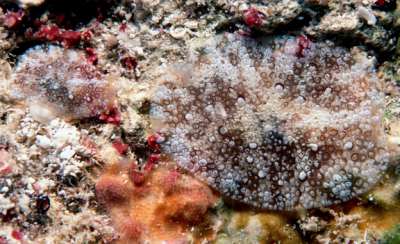
Hi Bill;
I think this is a Pleurobranchus areolatus. The upper right photo shows two of them.
Locality: Bahamas, Depth: 30 feet. Length: 3 inches. June 2002. Photographer: Keri Wilk
Les Wilk
wilk@reefnet.ca
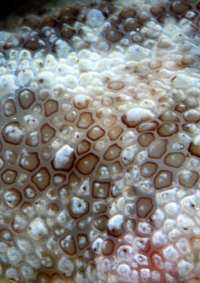
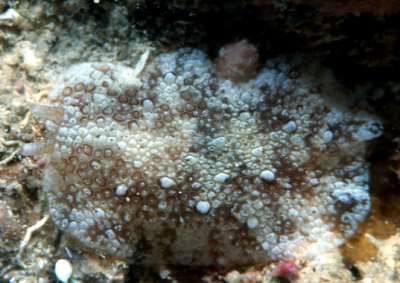
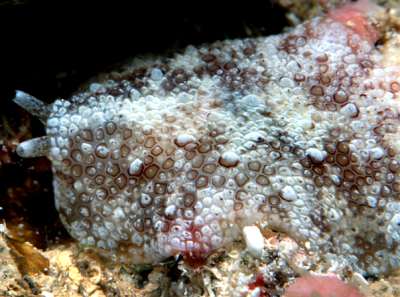
Dear Les,
Have a look at the messages and Fact Sheets for P. areolatus and P. atlanticus. I am pretty sure your animals are P. atlanticus. If you look at your photos you will see that scattered tubercles are larger than the others and have a heavy opaque white mark on them. It is not as obvious in your animals than most others on the Forum, but the white mark is usuall traingular in shape making these large tubercles look like a set of radiating white pointed papillae on the mantle.
Best wishes,
Bill Rudman
Pleurobranchus atlanticus from Jamaica
October 22, 2003
From: Ross W. Gundersen
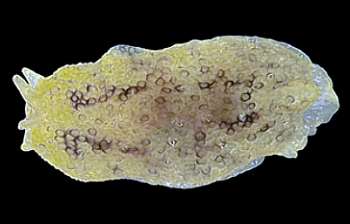
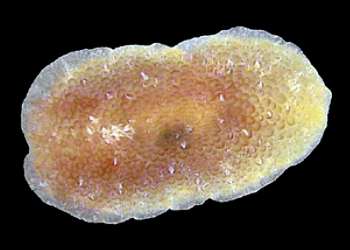
Dear Bill:
Here is another sea slug from Jamaica. As I said in my first message, all specimens were collected from St. Ann's Bay, Jamaica, West Indies. Photo: R. Gundersen.
This species was approximately 2 cm in length. Found under coral rock on back reef at 2m. May be juvenile Pleurobranchus areolatus. Papillae are proportionally greater in number and smaller, than P. areolatus with no polygonal papillae. Color ranging from very light yellow to darker yellow and reddish orange.
Best wishes,
Ross
ross.gundersen@uwp.edu
Gundersen, R.W., 2003 (Oct 22) Pleurobranchus atlanticus from Jamaica. [Message in] Sea Slug Forum. Australian Museum, Sydney. Available from http://www.seaslugforum.net/find/11138Thanks Ross,
This is a species I have identified previously as Pleurobranchus atlanticus. If it was from the Pacific I would call it Pleurobranchus albiguttatus.
Best wishes
Bill Rudman
Pleurobranchus evelinae = P. atlanticus
September 10, 2003
From: Bill Rudman
While checking references to Vinicius Anderson's message about P. areolatus from Brazil I noted Thompson's (1977) description of Pleurobranchus evelinae from Jamaica. In all external features this species matches Pleurobranchus atlanticus as defined on the Forum. Although Thompson does not describe the triangular white marks on some papillae, he mentions scattered white patches, which in an accompanying drawing are arranged in a wide ring around the mantle. He also describes 2 white juveniles with scattered brown rings and an orange border, just as in Anne Dupont"s photo on the Forum. I have no doubt that P. evelinae is a junior synonym of Pleurobranchus atlanticus.
• Thompson, T.E. (1977) Jamaican opisthobranch molluscs I. Journal of Molluscan Studies, 43(2): 93-139, pls.1-3.
Bill Rudman
Rudman, W.B., 2003 (Sep 10) Pleurobranchus evelinae = P. atlanticus. [Message in] Sea Slug Forum. Australian Museum, Sydney. Available from http://www.seaslugforum.net/find/10936Pleurobranchus atlanticus from Netherlands Antilles
September 18, 2002
From: Linda Ianniello
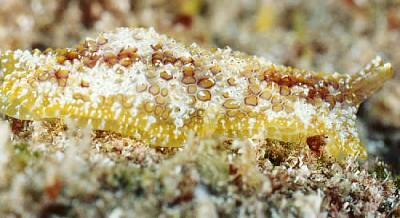
Dr. Bill,
I think this is a Pleurobranchus areolatus based on the description found in Paul Humann's book. His picture is of a much darker specimen but the text indicates it can also be fairly light-colored. You can barely see the two layers along the side, where the gills would be.
Location: 'Saba, Netherlands Antilles' dive site called Tent Wall
Depth: Approximately 40 feet
Length: About 2 inches
Date: July, 2002
I found this guy at the top of the reef, in a location with nothing but sand. When I first saw him, he had his head stuck in a small hole.
Regards,
Linda Ianniello
lindai@us.ibm.com
Ianniello, L., 2002 (Sep 18) Pleurobranchus atlanticus from Netherlands Antilles. [Message in] Sea Slug Forum. Australian Museum, Sydney. Available from http://www.seaslugforum.net/find/7815Dear Linda,
There is considerable confusion over the Caribbean pleurobranchs. Have a look at my my reply to Anne DuPont's message where I suggest this is really Pleurobranchus atlanticus.
Best wishes,
Bill Rudman
Pleurobranchus atlanticus from the West Indies
September 23, 2001
From: Anne DuPont
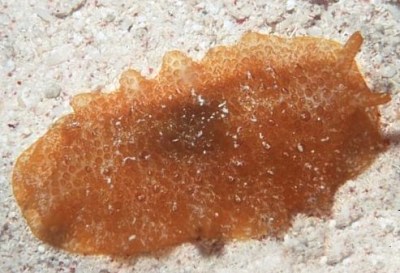
Hi Bill,
How are you and things at the museum?
In July of this year I was in the Cayman Islands, British West Indies, and photographed what I think was Pleurobranchus areolatus. It was orange, about 2 inches long, and crawling in the sand in about 35 feet of water. Can you confirm it's identity? Nearby I found a tiny white critter which was about one-half inch long. Is it a baby Pleurobranchus areolatus? Or something else?
Thank you again for your time and for the Forum.
Anne DuPont
Delray Beach, Florida, USA
akdupont@bellsouth.net
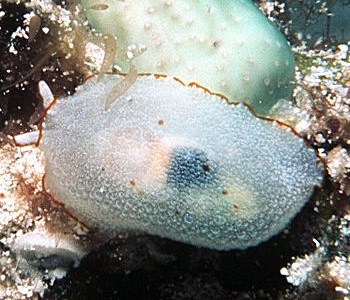
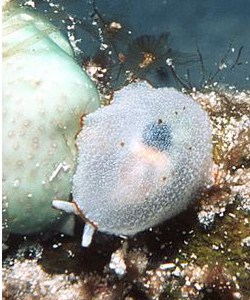
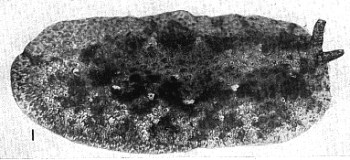
PHOTO: Pleurobranchus atlanticus. Photo by F.M.Bayer from original description (Abbott, 1949 - Pl.5. fig.1).
Dear Anne,
Thanks for your interesting photos. Although the white and brown animals look superficially quite different, the relatively small papillae and the lack of a permanent rhinophoral notch at the anterior end of the mantle suggest that the white animals are possibly juveniles of the brown species. My photos of Pleurobranchus peroni show a very similar colour change from juveniles to adults. But what is your species? I am sure it is the same as the animal from Colombia I have tentatively called P. cf. albiguttatus and which Humann identified as P. areolatus.
As I have said before, most reports on pleurobranchs from the western Atlantic have been based on preserved animals so it is difficult to know how many species there are and to identify living animals. Most authors seem to identify all Pleurobranchus they find in the Caribbean with Pleurobranchus areolatus, but that species was ill-described from preserved material. From my reading of the literature, P. areolatus has relatively large light brown 'warts' or polygonal tubercles, the bases outlined with darker brown. The anterior mantle has a permanent notch for the rhinophores. I would think that P. crossei Vayssiere, 1896 and Susania gardineri White 1952 are synonyms of P. areolatus.
As discussed elsewhere on the Forum it is also possible that P. testudinarius occurs in the Caribbean, but it would be easily recognisable from the elongate dorsal papillae.
Your animal does not fit either of those species. I think it is Pleurobranchus atlanticus Abbott, 1949 which was described from Florida. Marcus & Marcus (1967) include P. atlanticus in their synonymy of P. areolatus but I think they were mistaken. The original description of P. atlanticus includes a black & white photo of the living animal, which clearly shows it is different from what I think is P. areolatus. The tubercles are small and rounded and white streaks are clearly visible in their black & white photo, giving the appearance of white pointed papillae. They also say 'the size and depth of the [rhinophoral] sinus can be changed at will ... '
I am sure that your photos, and those from Colombia are Pleurobranchus atlanticus. Another species from Florida, Pleurobranchus reesi White 1952, is almost certainly a synonym of P. atlanticus. The living animal was described as 'reddish brown in living condition. In preservation ...... light brown in colour with dark sepia markings... evenly covered with soft rectangular papillae. Mantle entire .... not cleft in any way.'
I am not sure whether Pleurobranchus atlanticus is identical to the Indo-West Pacific species P. albiguttatus or not. It certainly looks identical externally. Until the anatomy of the two species can be compared I guess it is best to call your animal P. atlanticus. To my knowledge this is the first time Tucker Abbott's species, P. atlanticus, has been recognised as a distinct species.
Thanks again for the interesting photos. They made me look a bit deeper into the literature and hopefully sort out this problem. If you have photos of any other pleurobranchs from the western Atlantic I would be interested in seeing them. I would be interested in any comments on my suggested identification.
References:
• Abbott, R.T. (1949): A new Florida species of the Tectibranch genus Pleurobranchus. The Nautilus, 62(3): 73-78.
• Mörch, O.A.L. (1863) Contributions à la Faune malacologique des Antilles danoises. Journal de Conchyliologie, 11: 21-43.
• White, K.M. (1952) On a collection of molluscs from Dry Tortugas, Florida. Proceedings of the Malacological Society of London, 29: 106-120, Pl.6.
Best wishes,
Bill Rudman
Another notaspid from Colombia
October 22, 2000
From: Phanor Montoya

Dear Bill:
I have found two different species of pleurobranch here in Santa Marta, Caribbean coast of Colombia. They were collected in a bivalve larvae net collector and were 3-5 cm long. I think they belong to the genus Pleurobranchus. What do you think? I have sent photos of the other species in a separate message.
Sincerely yours,
Phanor Montoya
phamont@eudoramail.com


Dear Phanor,
Firstly, it seems that the right side of the mantle is damaged, as I think I can see part of the white gill which usually lies hidden below the mantle skirt.
The most distinctive feature of this species are the triangular white marks on some of the tubercles. You will note that those tubercles that have white triangular marks ae always a very dark brown colour. This gives the impression that the white marks are infact pointed white papillae. In Humann's book this species is identified as P. areolatus. As I discuss in your other message, I think P. areolatus is another species which lacks these white marks.
If this animal was from the Indo-West Pacific I would identify it as Pleurobranchus albiguttatus which I have found from east Africa to eastern Australia. It is not as common as Pleurobranchus peroni but is instantly recognisable by the white triangular marks. I have posted a page on P. albiguttatus from comparision. You won't find any references to this species in the literature because I think the name has not been used since Bergh's original description.
Until I get some feedback from others I will identify your animal as Pleurobranchus cf. abiguttatus but at least externally, I can find no obvious differences between it and the Indo-West Pacific species. This is a very intersting find.
Bets wishes,
Bill Rudman.
